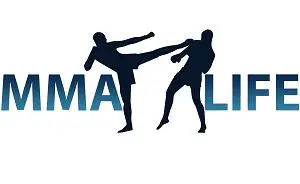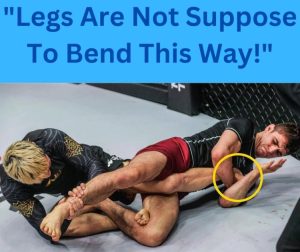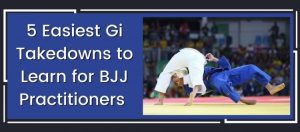“The choke is the king, the arm lock is the queen, but the foot lock is the dirty thief.“
A decade ago, being a specialist in the leg lock game was taboo and frowned upon, especially amongst the Brazilians. If you were one of the fighters who never passed the guard and just always kept diving for foot locks, more often than not people would have not wanted to roll with you.
Well, it’s 2021. Just like how the perspective and views of people about everything always change over time, so did their view on leg locks. As fighters like Craig Jones, Gary Tonon, Eddie Cummins, and Ryan Hall continue to dominate the scene with all their leg lock mastery, it is no surprise that Brazilian Jiu-Jitsu practitioners everywhere are trying to specialize in leg locks earlier into their careers.
Gone are the days when you were only allowed to start learning and using foot locks at blue and purple belt. Academies around the world have seen the benefit of learning how to defend and execute leg locks properly as early as white, and practitioners are just going to keep getting better.
To help you on your journey to mastering leg locks, we share with you 20 BJJ Black Belts Advice On Getting Good at Leg Locks so you can practice them the next time you step on the mat!

- Nicolas Gregoriades on learning footlocks at white belt
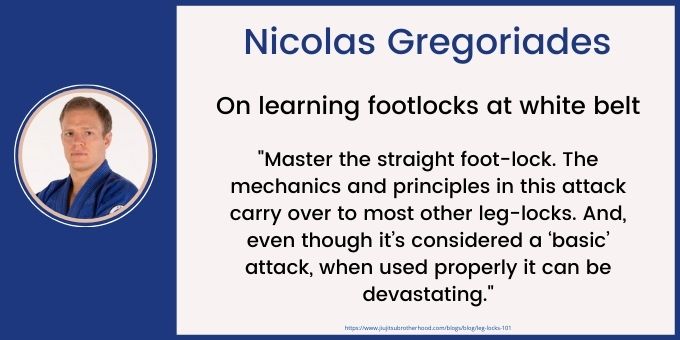
Master the straight foot-lock. The mechanics and principles in this attack carry over to most other leg-locks. And, even though it’s considered a ‘basic’ attack, when used properly it can be devastating.
2. John Danaher on leg control and the concept of “double trouble”
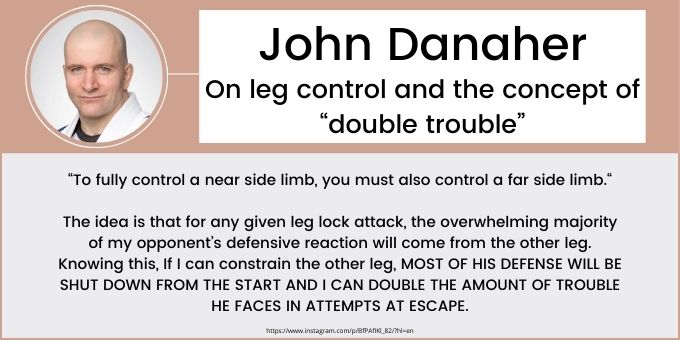
“To fully control a near side limb, you must also control a far side limb.“
The idea is that for any given leg lock attack, the overwhelming majority of my opponent’s defensive reaction will come from the other leg. Knowing this, If I can constrain the other leg, MOST OF HIS DEFENSE WILL BE SHUT DOWN FROM THE START AND I CAN DOUBLE THE AMOUNT OF TROUBLE HE FACES IN ATTEMPTS TO ESCAPE.
3. Dean Lister on positional sparring
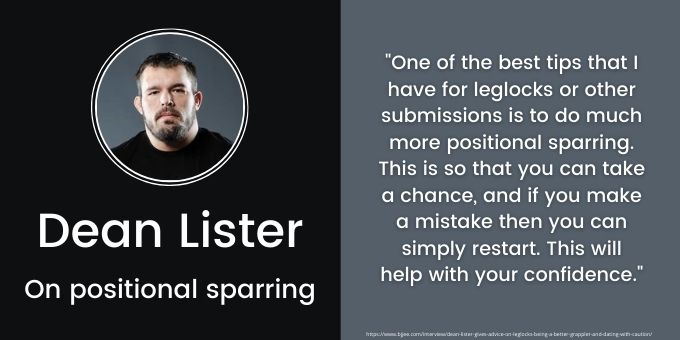
One of the best tips that I have for leglocks or other submissions is to do much more positional sparring. This is so that you can take a chance, and if you make a mistake then you can simply restart. This will help with your confidence.
4. Gary Tonon on why you should learn all submission
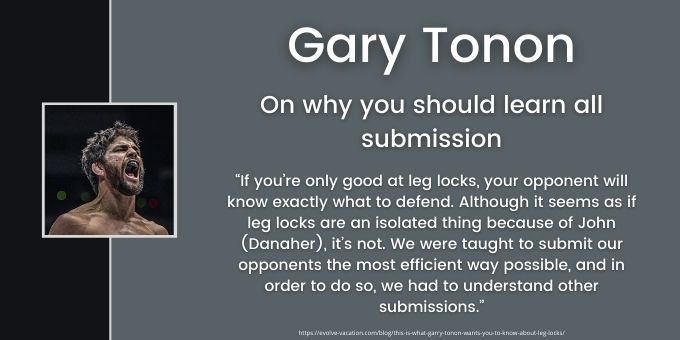
“If you’re only good at leg locks, your opponent will know exactly what to defend. Although it seems as if leg locks are an isolated thing because of John (Danaher), it’s not. We were taught to submit our opponents the most efficient way possible, and in order to do so, we had to understand other submissions.”
5, Tom De Blass on how to stop getting foot locked from Z guard
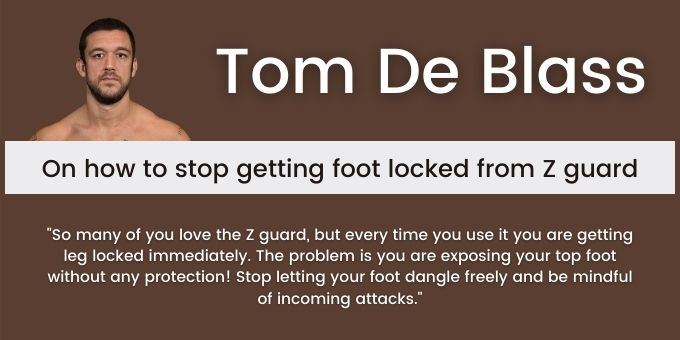
So many of you love the Z guard, but every time you use it you are getting leg locked immediately. The problem is you are exposing your top foot without any protection! Stop letting your foot dangle freely and be mindful of incoming attacks.
6. Firas Zahabi on how to properly train leglocks
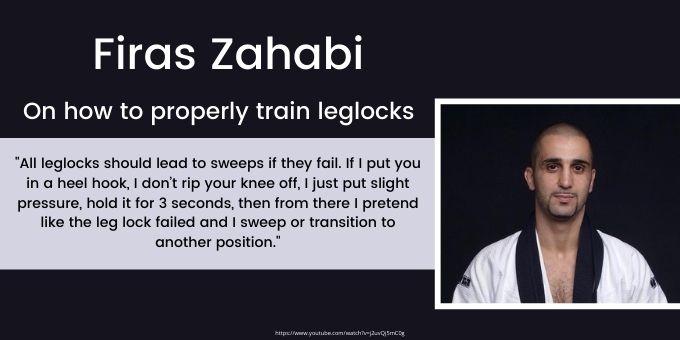
All leglocks should lead to sweeps if they fail. If I put you in a heel hook, I don’t rip your knee off, I just put slight pressure, hold it for 3 seconds, then from there I pretend like the leg lock failed and I sweep or transition to another position
7. Ryan Hall on being methodical with your leg attacks
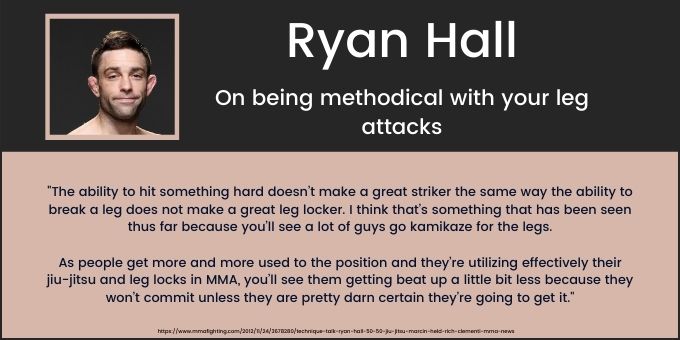
The ability to hit something hard doesn’t make a great striker the same way the ability to break a leg does not make a great leg locker. I think that’s something that has been seen thus far because you’ll see a lot of guys go kamikaze for the legs.
As people get more and more used to the position and they’re utilizing effectively their jiu-jitsu and leg locks in MMA, you’ll see them getting beat up a little bit less because they won’t commit unless they are pretty darn certain they’re going to get it.
8. Gabriel Arges on learning kneebars
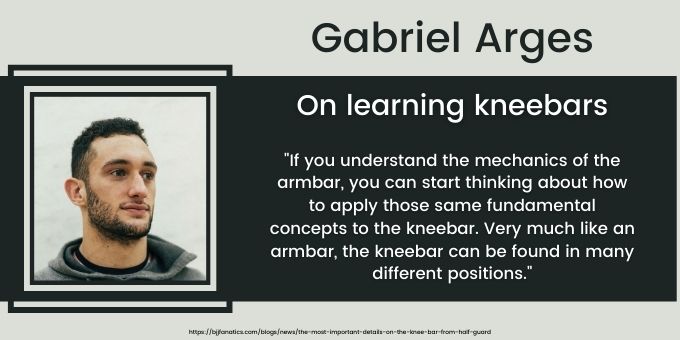
If you understand the mechanics of the armbar, you can start thinking about how to apply those same fundamental concepts to the kneebar. Very much like an armbar, the kneebar can be found in many different positions.
9. Eddie Cummings on the power of the heel hook

Of all the submissions, the heel hook, in particular, is the strongest joint lock we have. In that sense, it allows us to apply maximum breaking leverage to the weakest joint, relative to the other joints we know joint locks for. Be very careful when applying this submission, especially on training partners!
10. Jeff Glover on why foundation matters
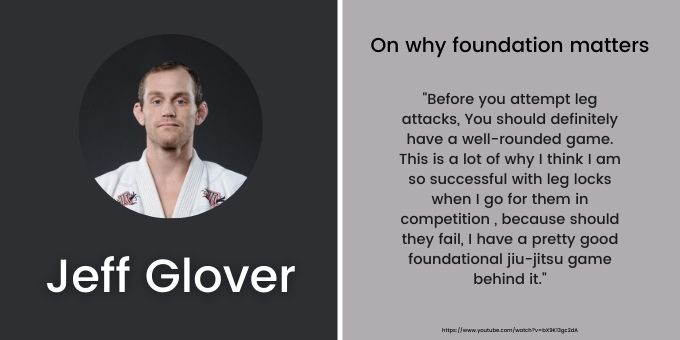
Before you attempt leg attacks, You should definitely have a well-rounded game. This is a lot of why I think I am so successful with leg locks when I go for them in competition , because should they fail, I have a pretty good foundational jiu-jitsu game behind it.
11. Frank mir on sacrificing position for submission
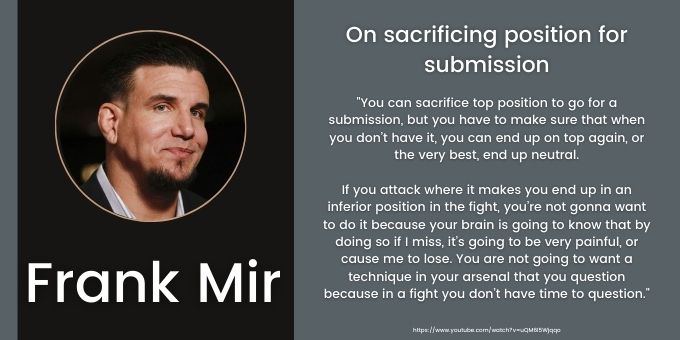
You can sacrifice top position to go for a submission, but you have to make sure that when you don’t have it, you can end up on top again, or the very best, end up neutral.
If you attack where it makes you end up in an inferior position in the fight, you’re not gonna want to do it because your brain is going to know that by doing so if I miss, it’s going to be very painful, or cause me to lose. You are not going to want a technique in your arsenal that you question because in a fight you don’t have time to question.
12. Josh Barnett on the fear of training leg locks and getting injured
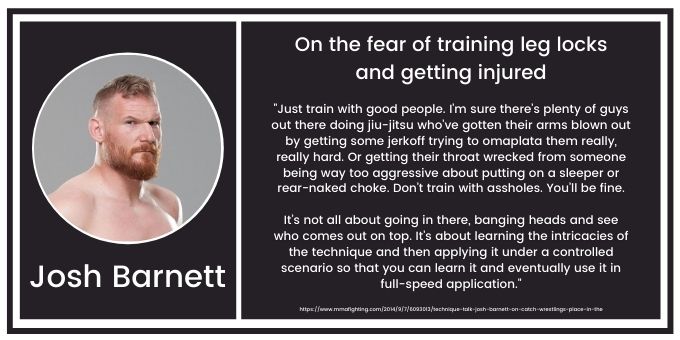
Just train with good people. I’m sure there’s plenty of guys out there doing jiu-jitsu who’ve gotten their arms blown out by getting some jerkoff trying to omoplata them really, really hard. Or getting their throat wrecked from someone being way too aggressive about putting on a sleeper or rear-naked choke. Don’t train with assholes. You’ll be fine.
It’s not all about going in there, banging heads, and see who comes out on top. It’s about learning the intricacies of the technique and then applying it under a controlled scenario so that you can learn it and eventually use it in full-speed application.
13. Victor Estima on the proper mindset of hunting foot locks

A lot of people think that the goal is to keep hunting the foot lock a lot. I think my mentality to get a foot lock is to forget about the foot. Dont worry about the foot lock and just play your game. Do what is necessary and the opportunity will come.
14. Braulio Estima on baiting the Estima Lock (and other foot locks)
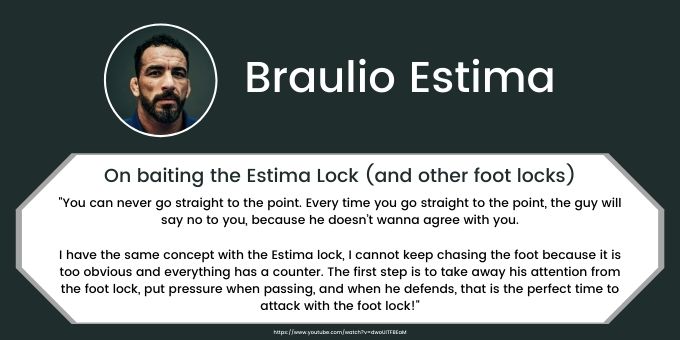
You can never go straight to the point. Every time you go straight to the point, the guy will say no to you, because he doesn’t wanna agree with you.
I have the same concept with the Estima lock, I cannot keep chasing the foot because it is too obvious and everything has a counter. The first step is to take away his attention from the foot lock, put pressure when passing, and when he defends, that is the perfect time to attack with the foot lock!
15. Mendes Brother on why you should add leg locks to your game
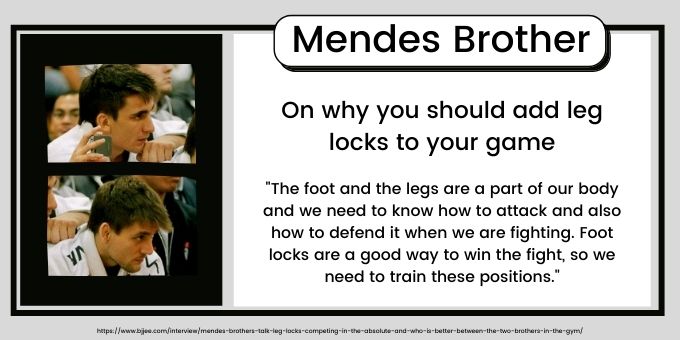
The foot and the legs are a part of our body and we need to know how to attack and also how to defend it when we are fighting. Foot locks are a good way to win the fight, so we need to train these positions.
16. Leandro Lo on why you should tap early
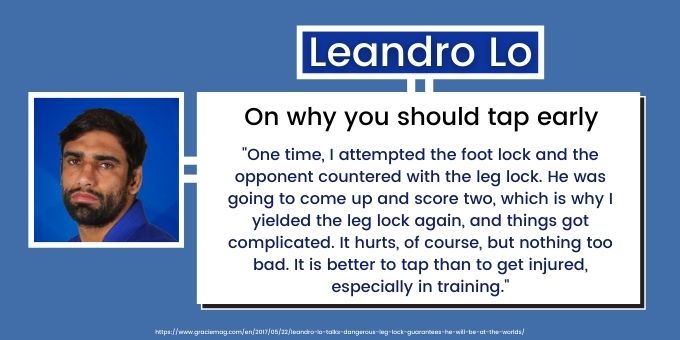
One time, I attempted the foot lock and the opponent countered with the leg lock. He was going to come up and score two, which is why I yielded the leg lock again, and things got complicated. It hurts, of course, but nothing too bad. It is better to tap than to get injured, especially in training.
17. Rickson Gracie on his thoughts on leg locks
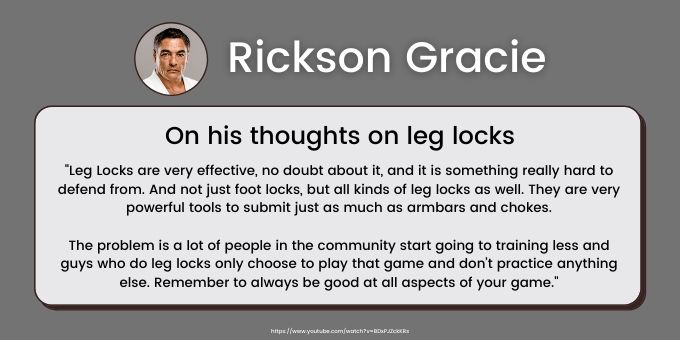
Leg Locks are very effective, no doubt about it, and it is something really hard to defend from. And not just foot locks, but all kinds of leg locks as well. They are very powerful tools to submit just as much as armbars and chokes.
The problem is a lot of people in the community start going to training less and guys who do leg locks only choose to play that game and don’t practice anything else. Remember to always be good at all aspects of your game.
18. Luis Panza on efficiently finishing straight foot locks
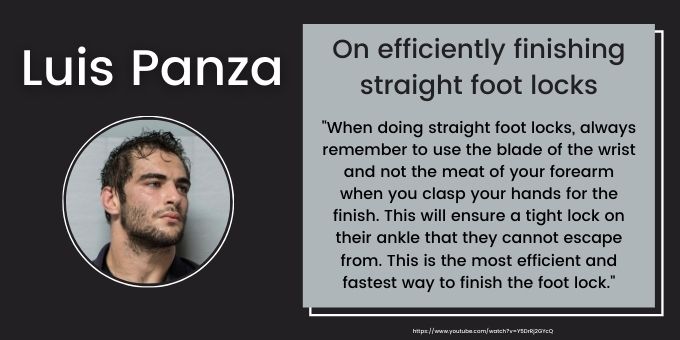
When doing straight foot locks, always remember to use the blade of the wrist and not the meat of your forearm when you clasp your hands for the finish. This will ensure a tight lock on their ankle that they cannot escape from. This is the most efficient and fastest way to finish the foot lock.
19. Lachlan Guiles on focusing on foot locks at white belt

I highly encourage not to just focus on foot locks at white belt. It will severely inhibit how good your guard passing gets. guard passing takes a long time to develop, foot locks you can develop reasonably quickly. Therefore you are doing yourself a disservice by focusing on just leg attacks.
20. Mikey Musumeci on the optimal way to finish the straight foot lock
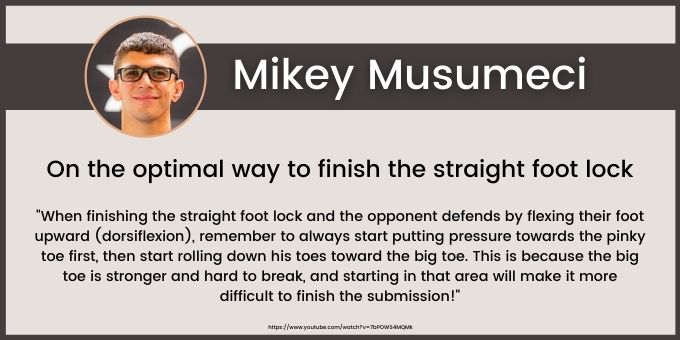
When finishing the straight foot lock and the opponent defends by flexing their foot upward (dorsiflexion), remember to always start putting pressure towards the pinky toe first, then start rolling down his toes toward the big toe. This is because the big toe is stronger and hard to break, and starting in that area will make it more difficult to finish the submission!
